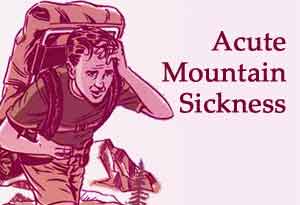- Home
- Editorial
- News
- Practice Guidelines
- Anesthesiology Guidelines
- Cancer Guidelines
- Cardiac Sciences Guidelines
- Critical Care Guidelines
- Dentistry Guidelines
- Dermatology Guidelines
- Diabetes and Endo Guidelines
- Diagnostics Guidelines
- ENT Guidelines
- Featured Practice Guidelines
- Gastroenterology Guidelines
- Geriatrics Guidelines
- Medicine Guidelines
- Nephrology Guidelines
- Neurosciences Guidelines
- Obs and Gynae Guidelines
- Ophthalmology Guidelines
- Orthopaedics Guidelines
- Paediatrics Guidelines
- Psychiatry Guidelines
- Pulmonology Guidelines
- Radiology Guidelines
- Surgery Guidelines
- Urology Guidelines
Altitude sickness prevention and management: Practice Guidelines

Wilderness Medical Society has recently released guidelines for the prevention and management of altitude sickness. The guideline aims to provide evidence-based guidance to clinicians for the management of acute mountain sickness, high altitude cerebral edema (HACE), and high altitude pulmonary edema (HAPE).
Commonly known as “mountain sickness,” an altitude sickness is a group of symptoms that can strike if an individual walk or climb to a higher elevation, or altitude above 2500 m. As large numbers of people travel to such elevations, many clinicians are faced with questions from patients about the best means to prevent these disorders. The present guideline sought to provide recommendations for effective treatment and management of the same.
Prevention
- Patients should be adviced to slowly increase sleeping elevation (ie, gradual ascent) to prevent acute mountain sickness (AMS), high-altitude cerebral edema (HACE), and high-altitude pulmonary edema (HAPE).
- Travelers in whom ascent to high altitude poses a moderate to high risk of AMS should be strongly considered for acetazolamide administration.
- Individuals who prefer not to take acetazolamide or dexamethasone or who have allergies or intolerance to these agents can be administered ibuprofen for AMS prevention.
- Acetazolamide should be strongly considered in travelers at moderate or high risk of AMS with an ascent to high altitude
- Acetazolamide can be used in children for prevention of AMS
- Dexamethasone can be used as an alternative to acetazolamide for adult travelers at moderate or high risk of AMS.
- Inhaled budesonide should not be used for altitude illness prophylaxis.
- Ginkgo biloba should not be used for AMS prevention.
- Ibuprofen can be used for AMS prevention in persons who do not wish to take acetazolamide or dexamethasone or have allergies or intolerance to these medications.
- Acetaminophen should not be used for AMS prevention.
- When feasible, staged ascent and preacclimatization can be considered as a means for AMS prevention
- Hypoxic tents can be used for facilitating acclimatization and preventing AMS, provided sufficiently long exposures can be undertaken regularly over an appropriate number of weeks and other factors, such as sleep quality, are not compromised.
Treatment
- The descent is effective for any degree of AMS/HACE and is indicated for individuals with severe AMS, AMS that fails to resolve with other measures, or HACE.
- Dexamethasone can be employed in place of acetazolamide in adults at moderate to high AMS risk.
- When available, ongoing supplemental oxygen sufficient to raise SpO2 to >90% or to relieve symptoms can be used while waiting to initiate descent or when the descent is not practical.
- When available, portable hyperbaric chambers should be used for patients with severe AMS or HACE when the descent is infeasible or delayed and supplemental oxygen is not available.
- Ibuprofen can be used to treat headache at high altitude.
- Acetazolamide should be considered for the treatment of AMS.
- Dexamethasone should be considered for the treatment of AMS.
- Dexamethasone should be administered to patients with HACE.
To read the full guideline, please follow the link

Disclaimer: This site is primarily intended for healthcare professionals. Any content/information on this website does not replace the advice of medical and/or health professionals and should not be construed as medical/diagnostic advice/endorsement or prescription. Use of this site is subject to our terms of use, privacy policy, advertisement policy. © 2020 Minerva Medical Treatment Pvt Ltd